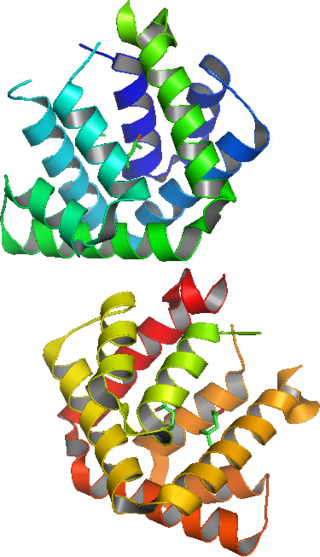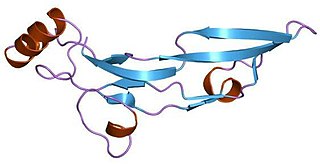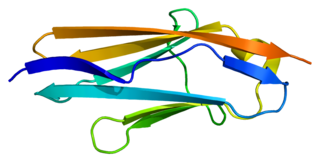
Fel d 1 is a secretoglobin protein complex that, in cats, is encoded by the CH1 and CH2 genes.

Uteroglobin, or blastokinin, also known as secretoglobin family 1A member 1 (SCGB1A1), is a protein that in humans is encoded by the SCGB1A1 gene.

The transforming growth factor beta (TGF-β) superfamily is a large group of structurally related cell regulatory proteins that was named after its first member, TGF-β1, originally described in 1983. They interact with TGF-beta receptors.
The testicular receptor proteins are members of the nuclear receptor family of intracellular transcription factors. There are two forms of the receptor, TR2 and TR4, each encode by a separate gene.

ATP-binding cassette sub-family A member 2 is a protein that in humans is encoded by the ABCA2 gene.

Striated muscle preferentially expressed protein kinase, in the human is encoded by the SPEG gene, a member of the myosin light chain kinase protein family. SPEG is involved in the development of the muscle cell cytoskeleton, and the expression of this gene has important roles in the development of skeletal muscles, and their maintenance and function. Mutations are associated with centronuclear myopathies a group of congenital disorders where the cell nuclei are abnormally centrally placed.

Secretoglobin family 3A member 2 is a protein that in humans is encoded by the SCGB3A2 gene.

BPI fold-containing family B, member 2, (BPIFB2) also known as bactericidal/permeability-increasing protein-like 1, is a protein that in humans is encoded by the BPIFB2 gene.

Secretoglobin family 1D member 2 is a protein that in humans is encoded by the SCGB1D2 gene.

ATP-binding cassette sub-family B member 8, mitochondrial is a protein that in humans is encoded by the ABCB8 gene.

The insulin/IGF/relaxin family is a group of evolutionary related proteins which possess a variety of hormonal activities. Family members in human include two subfamilies:

Major urinary proteins (Mups), also known as α2u-globulins, are a subfamily of proteins found in abundance in the urine and other secretions of many animals. Mups provide a small range of identifying information about the donor animal, when detected by the vomeronasal organ of the receiving animal. They belong to a larger family of proteins known as lipocalins. Mups are encoded by a cluster of genes, located adjacent to each other on a single stretch of DNA, that varies greatly in number between species: from at least 21 functional genes in mice to none in humans. Mup proteins form a characteristic glove shape, encompassing a ligand-binding pocket that accommodates specific small organic chemicals.

BPI fold containing family A, member 3 (BPIFA3) is a protein that in humans is encoded by the BPIFA3 gene. The gene is also known as SPLUNC3 and C20orf71 in humans and the orthologous gene in mice is 1700058C13Rik. There are multiple variants of the BPIFA3 projected to be a secreted protein. It is very highly expressed in testis with little or no expression in other tissues. The Human Protein Atlas project and Mouse ENCODE Consortium report RNA-Seq expression at RPKM levels of 29.1 for human testis and 69.4 for mouse, but 0 for all other tissues. Similarly, the Bgee consortium, using multiple techniques in addition to RNA-Seq, reports a relative Expression Score of 95.8 out of 100 for testis and 99.0 for sperm in humans; however low levels of BPIFA3 between 20 and 30 were seen for a variety of tissues such as muscle, glands, prostate, nervous system, and skin.

BPI fold-containing family B member 1 (BPIFB1) is a protein that in humans is encoded by the BPIFB1 gene. BPIFB1 is a secreted protein, expressed at very high levels in mucosa of the airways and salivary glands, and at moderate levels in the digestive tract and pancreas.

Transmembrane Protein 81 or TMEM81 is a protein that in humans is encoded by the TMEM81 gene. TMEM81 is a poorly-characterized transmembrane protein which contains an extracellular immunoglobulin domain.

The Rubicon homology domain is an evolutionarily conserved protein domain of approximately 250 amino acids that mediates protein–protein interaction. RH domains are present in several human proteins involved in regulation of autophagy and endosomal trafficking. While not all RH domains have been characterized, those of human Rubicon and PLEKHM1 mediate interaction with the small GTPase Rab7, which is found on late endosomes and autophagosomes.

BPI fold containing family B, member 5 is a non-human protein encoded by the Bpifb5 gene, also known as Lplunc5. The BPIFB5 protein and Bpifb5 gene have been characterized in mammals such as rodents and even-toed ungulates but are apparently lacking in primates and other vertebrates such as birds, reptiles, and amphibians. The protein in rodents is expressed at moderately high levels in mucosa of the airways and at moderate levels in salivary glands, esophagus, and gonads ; in even-toed ungulates expression is high in testis, moderate in brain and striated muscle, and low in kidney.

BPI fold containing family B, member 6 (BPIFB6), also known as bactericidal/permeability-increasing protein-like 3 (BPIL3), is a protein that in humans is encoded by the BPIFB6 gene, also known as BPIL3 and LPLUNC6. It is expressed at high levels in hypertrophic tonsils, at relatively moderate levels in oronasal epithelium including nasal mucosa, tongue, and salivary gland, as well as esophageal mucosa at lesser levels. Orthologs are present in many vertebrate species including mammals, birds, reptiles, and amphibians.

Vomeromodulin is a non-human protein also known as BPI fold containing family B, member 9 (BPIFB9) in the rat encoded by the Bpifb9/RYF3 gene, and as BPI fold containing family B, member 9A (BPIFB9A) encoded by the Bpifb9a gene in the mouse. This protein has been characterized in mammals such as rodents, carnivores, even-toed ungulates, insectivores, bats, lagomorphs, and shrews but is apparently absent in primates and other vertebrates such as birds, reptiles, and amphibians. Its function is associated with detection of chemical odorant pheromone molecules.

BPI fold containing family A, member 2 (BPIFA2), also known as Parotid Secretory Protein (PSP), is a protein that in humans is encoded by the BPIFA2 gene. The BPIFA2 gene sequence predicts multiple transcripts ; 2 mRNA variants have been well characterized. The resulting BPIFA2 is a secreted protein, expressed at very high levels in the parotid (salivary) gland; at high levels in oropharyngeal mucosa, including tongue; and at moderate levels many other tissue types and glands including mammary gland, testis, lung, bladder, blood, prostate, adrenal gland, kidney, and pancreas.










